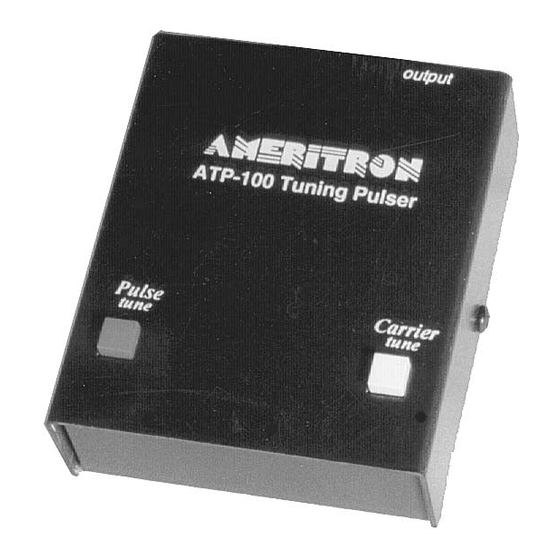AMERITRON ATP-100 Руководство по эксплуатации - Страница 3
Просмотреть онлайн или скачать pdf Руководство по эксплуатации для Усилитель AMERITRON ATP-100. AMERITRON ATP-100 8 страниц. Tuning pulser

ATP-100 Instruction Manual
Tuning Pulser
PULSE RATE and DUTY CYCLE
The ATP-100 has two internal controls that adjust Pulse rate and duty cycle. As
indicated by the names, these controls adjust the rate at which the transmit
keying pulses occur (pulse rate), and the ratio of on- to-off time (duty cycle).
The left control adjusts the Pulse rate, while the right control adjusts the duty
cycle.
Some care must be used to insure PULSE RATE is slow enough, and the DUTY
CYCLE is long enough, to be within the keying response limits of the exciter
and meter. If the pulse rate is too fast and/or the duty cycle is too long, the
pulses will blur into one long steady signal.
The typical exciter has a leading edge rise time and tailing edge decay time of a
few milliseconds. This stretches the pulse duty cycle out, making the actual RF
envelope have a longer duty cycle than the actual keying waveform from the
ATP-100. Because of this effect, the Ameritron ATP-100 Tuning Pulser may
actually produce a 100% duty cycle waveform at high (clockwise) PULSE
RATES with longer (clockwise) on-time DUTY CYCLE settings.
If the pulse rate is too slow and/or the duty cycle too slow, peak power will not
be reached. All exciters have a delayed response to the leading edge of the
keying waveform. This delay may prevent full peak power from being reached if
the duty cycle is too short. Most peak meters have limited response time, this
causes lower power readings with short duty cycle pulses.
Another problem is nearly all meters have limited storage time, causing the
meter to "fall-back" during the time interval between RF pulses. To obtain the
most accurate meter readings, both PULSE RATE and DUTY CYCLE should
be set far enough clockwise to allow maximum peak power to be indicated on a
scope or peak reading meter.
Some peak meters do not read true peak power at all, instead reading something
less than the true peak power. If your meter reads less power when the pulser is
used, compared to the power when a steady or near steady carrier is produced,
your meter is probably not a good peak reading meter. Nearly every radio and
amplifier produces more peak power than steady carrier power, because of ALC
response time and power supply voltage sag under load. Too much duty cycle
on-time can cause unwanted component heating.
3
